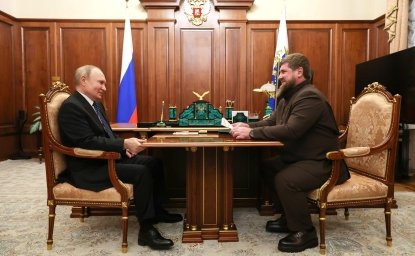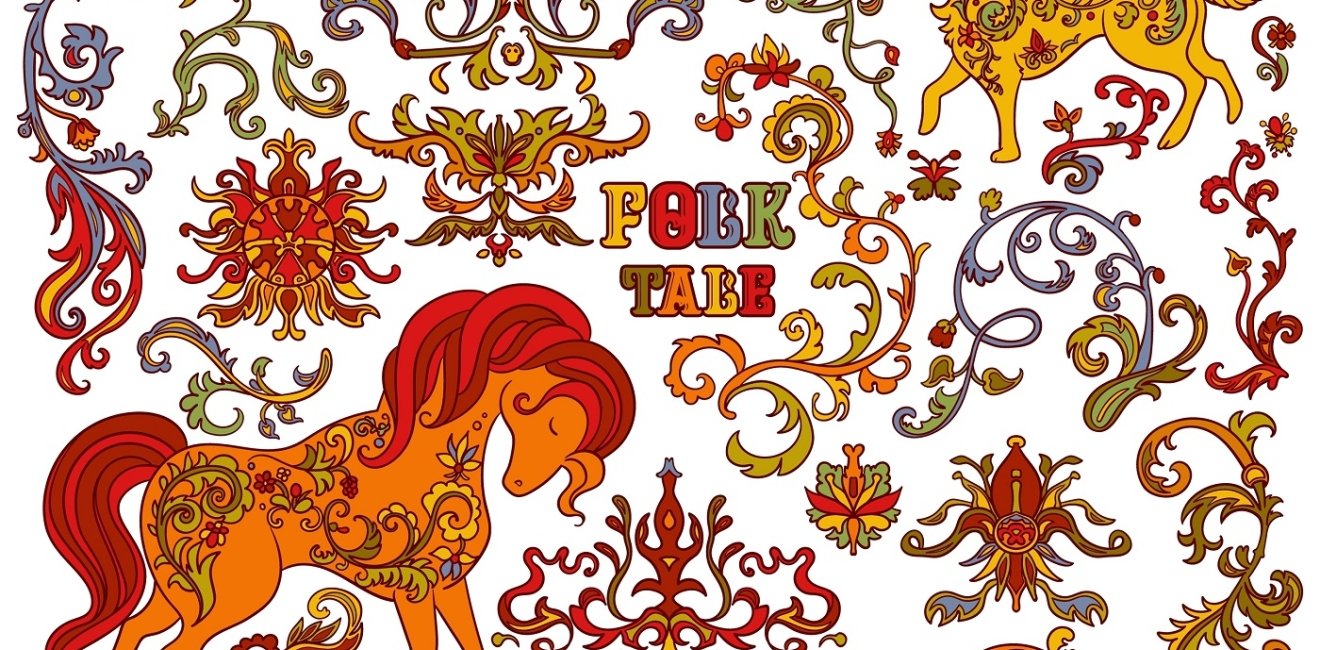
A blog of the Kennan Institute
In a time when foreign blockbusters are scarce in Russian cinemas, traditional fairy tales adapted for the big screen have become hits among Russian moviegoers. Films based on two favorite classics, The Little Humpbacked Horse (marketed in English as Upon the Magic Roads) and At the Pike’s Behest (also known as Wish of the Fairy Fish), became some of the highest-grossing films in the history of the Russian box office.
Cheburashka, a movie adapted from a Soviet-era children’s book, was a massive success last year. Ruslan and Ludmila, loosely based on characters created by Alexander Pushkin, is about to be released. Additionally, films based on “Pinocchio,” The Wizard of Oz, Hans Christian Andersen’s “The Tinderbox,” and Alexander Pushkin’s “The Tale of the Golden Cockerel” are in the works.
Two Ivans, Two Czars
Upon the Magic Roads was released one year before the invasion of Ukraine, while Wish of the Fairy Fish screened one year after. This timeline is reflected in the producers’ portrayal of the folk characters’ relationships. In the prewar Magic Roads, the main character, Ivan, faces a straightforward antagonist in a greedy and cunning czar. Some critics noted a subtle resemblance between Anton Shagin, the actor playing Ivan, and Alexei Navalny, who had recently returned to Russia. Mikhail Efremov, who played the czar, was widely known for reciting satirical and oppositional poetry. Shortly after the filming, Efremov was imprisoned, not for political reasons but for a fatal accident involving drunk driving.
Wish of the Fairy Fish’s protagonist, also named Ivan, finds his opponent not in the figure of the czar but in the czar’s daughter, who has fallen under bad Western influence. The czar himself is presented as a modest, hard-working, popular leader who is particularly interested in domestic manufacturing substituting for Western imports. He has even made his own crown, out of wood. Curiously, the archetypal evildoer, Koshchey, is seen in a positive light, while most of the mischief originates with the British ambassador, Lord Rothman.
Apart from the titles mentioned at the beginning, Russian audiences will soon be treated to Ilya Muromets, a tale of a bogatyr (a knight), a major character in Russian epic folklore. Principal photography is underway for the first installment of a franchise based on “The Malachite Maid,” a fairy tale by Pavel Bazhov.
Let’s not forget about fantasy series, which Russian streaming platforms continue to produce one after another. A highly popular and much-discussed series of 2023 was Magic Precinct, in which ordinary policemen solve fairy-tale crimes. In the attic of the magic police station, fairy-tale objects, from the magic tablecloth to seven-league boots, gather dust. The servants of law prosecute and send goblins, wood spirits, mermaids, and other creatures to a special “fairy-tale central,” a prison run by the Snow Queen.
Technology and Demand
One reason for the surge in productions is mastery of modern production technology and its accessible costs. With relatively modest budgets ($7 million for Wish of the Fairy Fish, about $8 million for Upon The Magic Roads, $12 million for Cheburashka, usually half of it provided by the state), Russian production designers have learned to create computer animations and graphics that are both presentable and engaging. However, technical progress alone does not fully explain this phenomenon.
All these dozens of new productions are a renaissance of a genre with a rich Soviet tradition, primarily associated with the names of Soviet screen writers and directors such as Alexander Rowe.
Rowe (1906–1973), whose father was an Irish engineer working in prerevolutionary Russia, became a Soviet film director who laid the foundations for didactic and sentimental folk movies in Soviet mass art. His directorial debut was a movie version of “At the Pike’s Behest” in 1938, the second year of Stalin’s purges. His third movie, The Little Humpbacked Horse, was released in 1941, right after Nazi Germany invaded the Soviet Union.
A Tale of National Victories
Eerie parallels are hard to ignore. Computer-animated versions of the same titles appear eighty years later in a Russia engaged in a war of aggression, amid stifled speech and effective wartime censorship.
Historical periods are never fully comparable. Yet it seems that both in Stalin’s time and now, the importance of the fairy tale is explained by the political power’s understanding of nation-building, of the national myth and identity.
Rowe went to the Russian artists of the early twentieth century for images of generalized peasants and bogatyrs. Some of today’s producers, including the creators of the animated saga The Three Bogatyrs, reference Soviet, or rather Stalinist, interpretation of folk epic stories. “In this production we easily recognize the characters created by the Soviet folk movies and animations,” writes the folklorist Svetlana Adonieva. “Bogatyrs were endowed with the virtues of Soviet man, which included selfless love for the motherland, a readiness to give one’s life for it, bravery that knows no limits, determination and courage.”
Alexander Rowe is also a frequent reference point for the creators of the latest blockbuster fairy tales. If we imagine the foundation of the civil nation of the Russian Federation, it will be largely made up of Soviet stereotypes. That is why film screenings of classic Soviet cartoons have such success at the box office. Fairy tales today fill the lacuna that has formed in the place of Russian identity.
But this is a demand from the government. There is also a demand from below, a much simpler and more obvious one. If in times of peace the rise of national moviemaking reflects a search for understanding the issues of the day, then in modern Russia, viewers understandably want to escape reality. That is why auteur cinema, which is trying to talk to the audience about current issues, usually flops at the box office. Russian viewers do not want to recognize themselves on the big screen. Hence fairy tales, preferably familiar and tried-and-true ones with a happy ending, in which good triumphs over evil.
A Tale of National Servitude
While viewers in Russia are watching old fairy tales, Russians in emigration are also watching movies, including Russian ones. One of the real hits, which was hotly discussed among those who left Russia and are scattered around the world, was Andrei Loshak’s documentary project Pentagon. The first episode of this four-part series garnered more than half a million views on YouTube.
“Pentagon” is a building in the town of Novouzensk in Saratov region. It is a hostel that is so poorly maintained that it has no hot water, heating, or sewer system. The house’s mostly low-income residents call it that because Pentagon for them is a large and sprawling building. This film is also, in a way, a tale, although there is nothing fictional about it.
When filming Pentagon, Andrei Loshak pursued an understandable goal: to show that people in Russia do not live but survive, and that the question of supporting the “special military operation”—that is, Russia’s war—for them is by and large not on the agenda. Pentagon poses the question of whether Russians have any agency and gives a negative answer to it. The theme of the servitude of the film’s characters, their total inability to influence their own destiny in any way, reaches its climax in the episode in which the film crew decides to hire a lawyer who would help the residents defend their rights and improve their living conditions. The attempt ends in failure: people are afraid that something worse might happen and refuse the services of well-wishers.
For four hours we are told that the Pentagon is a metaphor for modern Russia. And it is at this level of generalization that what is happening on the screen turns into a fairy tale. And it is quite easy to imagine how this tale about unwashed Russia is watched with barely concealed glee by those who have left the country. Pentagon confirms their innermost thoughts about what they have parted ways with. Many do transfer donations to the residents of the “Pentagon”: there is a special group on the Telegram messaging app where the authors, to their credit, track the fate of their characters after the online premiere.
I do not know whether it is worth wasting time to explain that Russia is in no way reducible to a Pentagon. That the Russian government designates all sorts of regional human rights organizations as foreign agents, not just famous media personalities. That publishing houses, independent theaters, and charities work in Russia under difficult conditions. And finally, that there are people, and not necessarily well-educated people, who feel very bad about what is happening to their country. That there are many of these people, and that they are very different. That there are many more decent people left in Russia than there are people who left it, just as was so a hundred and fifty years ago. And that the most developed countries also have their own “pentagons,” but usually comprising artists or scholars, not people living below the poverty line, turning their lives into a metaphor for the structure of the entire society.
Since we are talking about tales here, there is no need to prove its fictions. Yes, the Russian czar is not good at all, and his crown is not made of wood. Those who have left and those who remain in Russia are watching two fairy tales. One is about a good and rich Russia, the other is about a poor and evil Russia. They are watching and finding comfort in both shows.
This article is a translation of a piece that originally appeared on In Other Words. It has been edited for clarity.
The opinions expressed in this article are those solely of the author and do not reflect the views of the Kennan Institute.
Author


Kennan Institute
The Kennan Institute is the premier US center for advanced research on Eurasia and the oldest and largest regional program at the Woodrow Wilson International Center for Scholars. The Kennan Institute is committed to improving American understanding of Russia, Ukraine, Central Asia, the South Caucasus, and the surrounding region through research and exchange. Read more

Explore More in The Russia File
Browse The Russia File
Chechnya as a Model of Modern Russia

Russia’s Indigenous Communities and the War in Ukraine

Gas and Power in a Changing US–Russia Relationship

